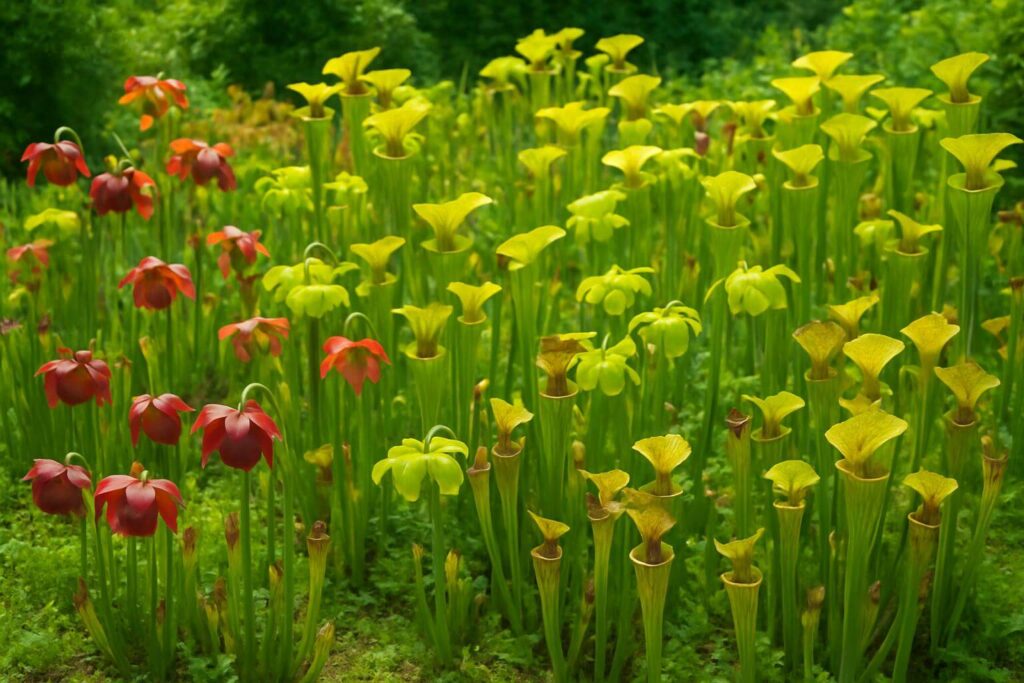
A Plant with a Strange History
The pitcher plant has always stood out in nature. Its strange, cup-shaped leaves fascinated early travellers. Ancient writings from Asia describe its hollow pitchers that held rainwater and trapped insects. In some cultures, people used the natural cups to carry water or even cook small meals. This unique use gave the plant both practical and symbolic value. Early botanists studied it with wonder. They saw how a plant could hunt like an animal. This history still makes it one of the most remarkable plants known today.
Why Pitcher Plant Grow a Garden Idea Works
When people think about gardens, they picture roses, tulips, or maybe herbs. But pitcher plant grow a garden is a bold twist. The plant does more than look exotic. It provides a function. Its pitchers act like natural traps for insects. Flies, mosquitoes, and ants crawl inside, only to be digested. For gardeners, that means fewer pests without using sprays. It becomes a living solution, mixing beauty with balance. Watching it at work feels like watching nature’s own invention in action.
Pitcher Plant Care in a Garden
Caring for pitcher plants is different from caring for regular flowers. They prefer moist, acidic soil and thrive in moss-filled pots or bog-like corners of a garden. These Plants cannot handle dry, sandy beds. They also dislike tap water because minerals harm them. Rainwater or distilled water works best. They enjoy sunlight but not the harsh mid-day heat. Place them where they get morning light and afternoon shade. With these conditions, the plant rewards you with bright pitchers that glow in shades of red, green, or purple. Gardeners who give proper care often see their pitcher plants multiply, creating a dramatic display.
A Twist in the Tale of Growth
What makes pitcher plant grow a garden truly different is its character. Most plants take, but this one also gives back. It provides pest control, conversation, and curiosity. Guests in your home may stare at it longer than at a rose bush. Children love to watch how it works. The plant changes the way people think about gardening. Instead of just growing beauty, you grow a small hunter in green. It shows how survival can be art. This twist in gardening makes it unforgettable.
The Future of Pitcher Plant Gardens
Many species of pitcher plants face threats in the wild. Forest clearing and climate change reduce their natural habitats. By growing them at home, gardeners take part in conservation. Each plant grown in a backyard adds to survival chances. It also creates awareness. People learn that plants can be rare, valuable, and fragile. Pitcher plant gardens may even grow into a trend as more people look for unique, eco-friendly setups. They offer a mix of history, science, and beauty in one space. For gardeners who want to stand apart, the pitcher plant is the answer.
Pitcher Plant as a Teacher
More than just a decoration, this plant teaches lessons. It shows patience, as growth takes time and shows adaptation, as it evolved to live where soil was poor. It shows balance, by keeping insect numbers in check. Growing it in your garden makes you part of this story. Each new pitcher that opens is like a chapter in nature’s book. It reminds us that gardens are not just about flowers but about life itself.
Closing Thoughts
Building a garden with pitcher plants is more than planting. It’s storytelling, conservation, and a twist on tradition. It connects the past, where explorers admired its strange design, to the present, where gardeners use it for both function and beauty. It also points to the future, where rare plants may survive because people choose to grow them. Pitcher plant grow a garden is not just a title. It is an idea that blends survival, creativity, and respect for the world around us.




